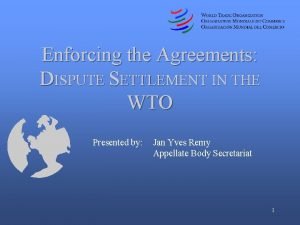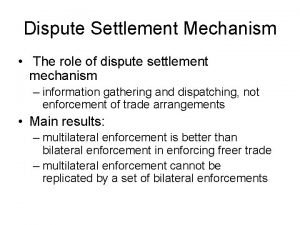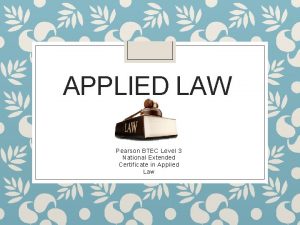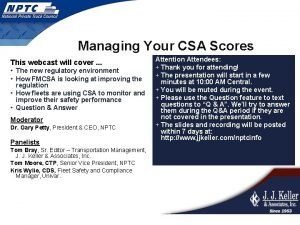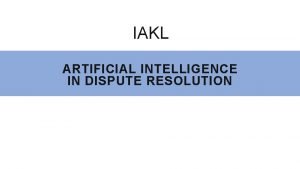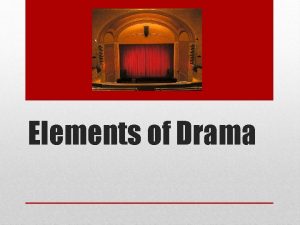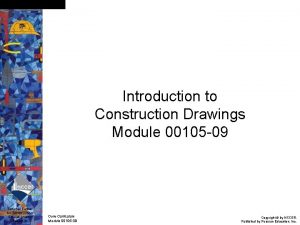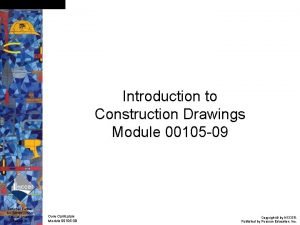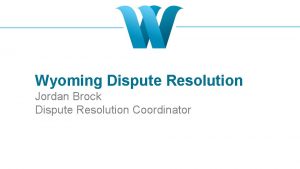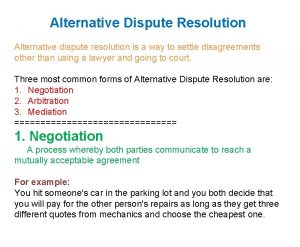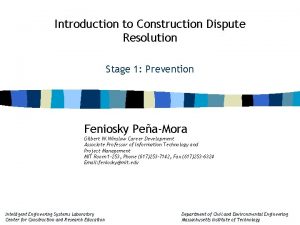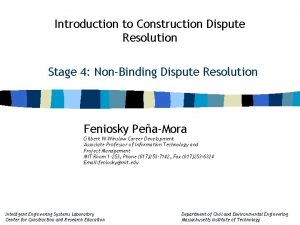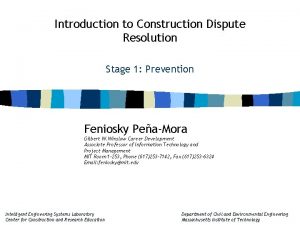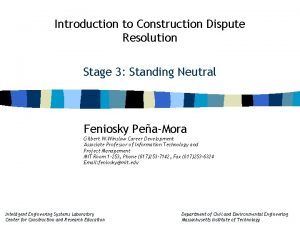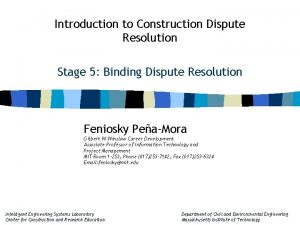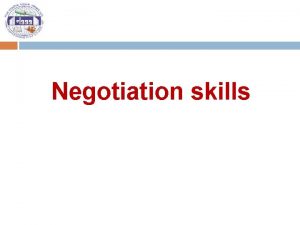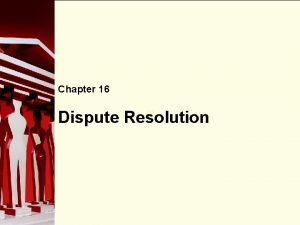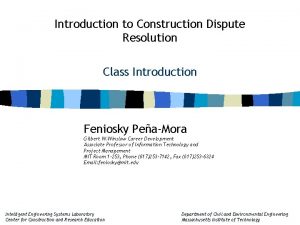Introduction to Construction Dispute Resolution Stage 2 Negotiation



























![References n n n n 28 n [AAA, 1996] : American Arbitration Assiociation. Building References n n n n 28 n [AAA, 1996] : American Arbitration Assiociation. Building](https://slidetodoc.com/presentation_image_h2/ab74cd71b5a4d53e42a26d5a0be08a47/image-28.jpg)
- Slides: 28

Introduction to Construction Dispute Resolution Stage 2: Negotiation Feniosky Peña-Mora Gilbert W. Winslow Career Development Associate Professor of Information Technology and Project Management MIT Room 1 -253, Phone (617)253 -7142, Fax (617)253 -6324 Email: feniosky@mit. edu Intelligent Engineering Systems Laboratory Center for Construction and Research Education Department of Civil and Environmental Engineering Massachusetts Institute of Technology

Definitions n WHAT • Participants’ Interaction for Problem Resolution n WHO • Participants in All Levels of Management n WHY • Mutual Acceptable Solution • Avoidance of Conflict Escalation • Time and Money Saving, Relationship Rescue n HOW • Distinction Between Positions and Interests 2 • Negotiation Style and Techniques Congruent With Atmosphere Introduction to Construction Dispute Resolution Chapter 5: Negotiation © Peña-Mora, et. al. 2002

Highway Interchange Project 3 n Underground Highway Interchange Construction Project n Design-bid-build Contract, 3 ½ Year Project n Major Participants: Owner, Program Manager, General Contractor, Designer n Major Impedance: Interference With 10 Other Contracts n High Risk of Schedule Delays n Construction Starting up With Incomplete Design Due to Tight Schedule n 13 Major Design Changes After Bid Award n Main Change Order Related to the Closure of the Tunnels; 21% Price Increase From Original Contract Price Introduction to Construction Dispute Resolution Chapter 5: Negotiation © Peña-Mora, et. al. 2002

Case Study: Important Issues n Could the Owner Have Foreseen the Change Orders Before Construction Startup? n Could This Change Order Be Handled in a Non Confrontational Manner? n Could This Change Order Be Resolved Through Simple Negotiations at the Jobsite? n Should the General Contractor Take a Hard Position on Some of the Issues that the Owner Would Consider More Important? n What Are the Interests/positions of the Owner or the Contractor? n What Are the Sources of Power of the Negotiating Parties? n Are the Interests of the Owner and the Contractor Aligned? 4 Introduction to Construction Dispute Resolution Chapter 5: Negotiation © Peña-Mora, et. al. 2002

Outline Ø The Field of Negotiation n Positions versus Interests n Negotiation Styles n Preparation n Step Negotiation n Structured Negotiations n Facilitated Negotiations/Meetings 5 Introduction to Construction Dispute Resolution Chapter 5: Negotiation © Peña-Mora, et. al. 2002

The Field of Negotiation n Theories of Negotiation Taught in Business and Law School Programs n Negotiation as the Second Stage Following Prevention and the First Phase in Dispute Resolution n Negotiations Defined as Communications between Parties in an environment of Trust, Collaboration and Objective Alignment to Get Jointly a Solution to a Problem Acceptable by All Parties n Result : Fair and Amicable Settlement Through Communication, Win/win Outcome n No Involvement of a Third-Party 6 Introduction to Construction Dispute Resolution Chapter 5: Negotiation © Peña-Mora, et. al. 2002

Outline ü The Field of Negotiation Ø Positions versus Interests n Negotiation Styles n Preparation n Step Negotiation n Structured Negotiations n Facilitated Negotiations/Meetings 7 Introduction to Construction Dispute Resolution Chapter 5: Negotiation © Peña-Mora, et. al. 2002

Positions vs. Interests n Focus in Negotiations on Individual and Collective Interests rather than Positions • Example of a Position: “He wants $100, 000 for the change order now. ” • Example of an Interest: “Although he is willing to do the extra work, he is low on cash and cannot fund the work. ” 8 n Interest-Based Negotiations Leading to “Non-Zero Sum” Solutions and Avoiding Court n A “Zero Sum” Solution is When Benefits for One Party Are Expenses for the Other n “Positional” Bargaining as a Common Practice in Construction: Assuming a Position and Defending it Based on Contract Clauses and Law Introduction to Construction Dispute Resolution Chapter 5: Negotiation © Peña-Mora, et. al. 2002

Positions vs. Interests : Example n n 9 A Position-Based Negotiation Between SUB and GC: • SUB: I will not be able to finish on time. • GC: You will finish as scheduled. • SUB: I need two extra weeks. • GC: You cannot have two weeks. • SUB: If I do not get two weeks, I will not be able to finish on time. • GC: No, you will finish according to the contract or we will collect damages and replace you. An Interest-Based Negotiation Between SUB and GC: • SUB: I will not be able to finish on time. • GC: Why Can’t you finish as promised? What are the reasons? • SUB: My supplier will not be able to deliver the materials until next week, causing me to finish two weeks behind schedule. • GC: As you know, the schedule is very tight for this project and there is little float available. Are there any other suppliers who can deliver on time? • SUB: Yes, but they are more expensive, more than the damages incurred by finishing late. • GC: Although you are responsible for meeting the milestone, I understand your dilemma. Let me see what I can do. I know some other suppliers that might be able to help. Introduction to Construction Dispute Resolution Chapter 5: Negotiation © Peña-Mora, et. al. 2002

Negotiation Aspects n Substantive: Money, Time, Long-term Market n Procedural: Confidentiality, Protocol, Administration n Psychological: Need for Respect, Status, Security, Recognition 10 Hollands, 1989 Introduction to Construction Dispute Resolution Chapter 5: Negotiation © Peña-Mora, et. al. 2002

Outline ü The Field of Negotiation ü Positions versus Interests Ø Negotiation Styles n Preparation n Step Negotiation n Structured Negotiations n Facilitated Negotiations/Meetings 11 Introduction to Construction Dispute Resolution Chapter 5: Negotiation © Peña-Mora, et. al. 2002

Negotiation Styles n Avoiding: Ignoring Worthless Problems n Competing: Refusing to Budge n Accommodating: Meeting the Interests of Requests of the Other Side n Compromising: Finding the Middle Ground When All Parties Have Valid Complaints n Collaborating: Finding a Common Ground 12 Introduction to Construction Dispute Resolution Chapter 5: Negotiation © Peña-Mora, et. al. 2002

Examples of Negotiation Styles n Avoiding: Compare the two situations • Situation 1 : Union Workers are upset because there are only 20 bathrooms on-site instead of 22. -This Problem is not worth a lot of time. • Situation 2 : Union Workers are upset because there are 20 bathrooms on-site and no female bathrooms. - This may be a legitimate problem that should not be ignored. n Competing: Compare the two positions • Sub requests some leniency in meeting certain safety requirements. • GC firmly refuses because he /she is responsible for safety on construction site. - Adequate Usage of the Competing Style 13 • Sub continues with the competing style. -Unwise Position Introduction to Construction Dispute Resolution Chapter 5: Negotiation © Peña-Mora, et. al. 2002

Examples of Negotiation Styles n Accommodating: Refer to the Previous Example • The SUB Should Take an Accommodating Style So He Reaches an Acceptable Outcome Even If He Is at Fault n Compromising: Adverse Weather Conditions • Contractor Asks 10 -day Time Extension. • Owner Thinks That the Weather Does Not Impede the Work. • Both Parties Compromise: the Contractor Is Given a 6 day Time Extension n 14 Collaborating: Contractor and Designer Brought Into the Project Early to Give Their Input and Help Steer the Project Based on Their Expertise Introduction to Construction Dispute Resolution Chapter 5: Negotiation © Peña-Mora, et. al. 2002

Outline ü The Field of Negotiation ü Positions versus Interests ü Negotiation Styles Ø Preparation n Step Negotiation n Structured Negotiations n Facilitated Negotiations/Meetings 15 Introduction to Construction Dispute Resolution Chapter 5: Negotiation © Peña-Mora, et. al. 2002

Preparation n Determination of the Best Alternative To a Negotiated Agreement • Example: An Owner Negotiating with Contractor 1 for the Lowest Price on a Quality Guaranteed Contract- Bid Price=$100, 000. For the Negotiation with Contractor 2, the BATNA is $100, 000 n Identification of the Sources of Power of Each Party n Determination and Prioritization of Needs and Interests Prior to Facing the Other Party n Developing Solutions Acceptable to Both Sides 16 Introduction to Construction Dispute Resolution Chapter 5: Negotiation © Peña-Mora, et. al. 2002

Outline ü The Field of Negotiation ü Positions versus Interests ü Negotiation Styles ü Preparation Ø Step Negotiation n Structured Negotiations n Facilitated Negotiations/Meetings 17 Introduction to Construction Dispute Resolution Chapter 5: Negotiation © Peña-Mora, et. al. 2002

Step Negotiation Communication Lines Step 3 Level 3 (e. g. , V. P. Operations) Level 2 (e. g. , Project Manager) Level 1 (e. g. , Field Supervisor or Project Engineer) Level 3 (e. g. , Senior Management) Step 2 Level 2 (e. g. , Project Representative Step 1 Level 1 (e. g. , Architect or Engineer) CONTRACTOR ORGANIZATION OWNER ORGANIZATION Peña-Mora, et. al, 2002 18 Introduction to Construction Dispute Resolution Chapter 5: Negotiation © Peña-Mora, et. al. 2002

Outline ü The Field of Negotiation ü Positions versus Interests ü Negotiation Styles ü Preparation ü Step Negotiation Ø Structured Negotiations n Facilitated Negotiations/Meetings 19 Introduction to Construction Dispute Resolution Chapter 5: Negotiation © Peña-Mora, et. al. 2002

Structured Negotiations Steps n Selection of Authorized Agents by Each Party n Final Settlement of Some Disputed Items by Agents n Adjudication of Unresolved Disputed Items by a Third Party Neutral n Documentation of Decisions and Administration of Contract Changes 20 Introduction to Construction Dispute Resolution Chapter 5: Negotiation © Peña-Mora, et. al. 2002

Pros of Structured Negotiation n Process Control and Time Saving n Expertise of Agents 21 Introduction to Construction Dispute Resolution Chapter 5: Negotiation © Peña-Mora, et. al. 2002

Outline ü The Field of Negotiation ü Positions versus Interests ü Negotiation Styles ü Preparation ü Step Negotiation ü Structured Negotiations Ø Facilitated Negotiations/Meetings 22 Introduction to Construction Dispute Resolution Chapter 5: Negotiation © Peña-Mora, et. al. 2002

Facilitated Negotiations n Neutral third party acting as a facilitator n Two negotiation phases • Clear definition of both parties’ claims • Exploration of settlement strategies for a win/win outcome 23 Introduction to Construction Dispute Resolution Chapter 5: Negotiation © Peña-Mora, et. al. 2002

The Facilitator n Role of Facilitator • Channel of Communication • Translator of Position into Common Ground for Settlement n Facilitator’s Attributes as Specified by AAA • Impartiality and Trustworthiness • Basic Understanding of Construction • Solid Organizational Skills 24 • Knowledge Of ADR and Arbitration Introduction to Construction Dispute Resolution Chapter 5: Negotiation © Peña-Mora, et. al. 2002

Outline ü The Field of Negotiation ü Positions versus Interests ü Negotiation Styles ü Preparation ü Step Negotiation ü Structured Negotiations ü Facilitated Negotiations/Meetings 25 Introduction to Construction Dispute Resolution Chapter 5: Negotiation © Peña-Mora, et. al. 2002

Highway Interchange Project 26 n High Potential of Conflict Prior to Construction Startup n Delivery System (DBD) Incompatible With the Incomplete Design n Changes, Variations and External Uncertainty n Incomplete Scope Definition-internal Uncertainty n Owner and Contractor With Similar Interests n Successful Interest Based Negotiation n Collaborative/compromising Strategy n Equitable Cost Compensation for the Contractor n $US 31 million Paid to Contractor at 80% Completion n An Independent 3 rd Party Hired by the Owner to Verify the Numbers n Construction Completion on Time Introduction to Construction Dispute Resolution Chapter 5: Negotiation © Peña-Mora, et. al. 2002

Summary 27 n Negotiation as the First Stage after the Occurrence of a Dispute n Participants with High Degree of Control Over the Possible Outcomes n Possible Involvement of a Third Party Facilitator n Interests Based rather than Positions Based Negotiations n Attempt to Reach a Non-zero Sum solution with a Win-win Outcome n Different Negotiation Styles: Avoiding, Competing, Accommodating, Compromising, Collaborating n Three Techniques in the Negotiation Process : Step, Structured and Facilitated Negotiations Introduction to Construction Dispute Resolution Chapter 5: Negotiation © Peña-Mora, et. al. 2002
![References n n n n 28 n AAA 1996 American Arbitration Assiociation Building References n n n n 28 n [AAA, 1996] : American Arbitration Assiociation. Building](https://slidetodoc.com/presentation_image_h2/ab74cd71b5a4d53e42a26d5a0be08a47/image-28.jpg)
References n n n n 28 n [AAA, 1996] : American Arbitration Assiociation. Building Success for the 21 st Century: A Guide to Partnering in the Construction Industry. Dispute Avoidance and Resolution Task Force of the American Arbitration Association. 1996. [Berman, 1995] : Berman, Gary S. , (1995). Facilitated Negotiation, An Effective ADR Technique. Dispute Resolution Journal pp. 18 -29. April-June [Boskey, 1993] : Boskey, James B. , (1993). Blueprint for Negotiations. Dispute Resolution Journal pp. 8 -19. December [Fisher, 1981] : Fisher, Roger, Getting to yes : negotiating agreement without giving in / Boston: Houghton Mifflin, 1981. [Hill, 1995] : Hill, Richard, (1995). Non-Adversarial Mediation. Dispute Resolution Journal pp. 43 -46. July [Hoctor, 1989] : Hoctor, David, (1989). Techniques for the Resolution of Major Construction Contract Disputes. Public Utilities Fortnightly Vol. 123 (9) pp. 26 -30. April 27 [Hollands, 1989] : Hollands, David S. FIDIC Provision for Amicable, Settlement of Disputes. International Construction Law Review. Issue 1. pp. 33 -43. 1989 [Kane, 1992] : Kane, Christopher. Mitigation Construction Contract Disputes. Public Utilities Fortnightly. Vol. 130 (1). pp. 11 -12. July 1992. [Langeland, 1995] : Langeland, Erik, (1995). The Viability of Conciliation in International Dispute Resolution Journal pp. 34 -41. July [Lewicki et al. , 1985] : Lewicki, Roy. Negotiation : readings, exercises, and cases / Homewood, Ill. : R. D. Irwin, 1985. [Peña-Mora et al, 2002] : Peña-Mora, F. , Sosa, C. , and Mc. Cone, S. Introduction to Construction Dispute Resolution. Prentice Hall, New Jersey, 2002. [Susskind et al. , 1987] : Susskind, Lawrence. Breaking the impasse : consensual approaches to resolving public disputes / New York : Basic Books, c 1987. [Thomas, 1976]: Thomas, Kenneth. Handbook of Industrial and Organizational Psychology. Chicago. Rand Mc. Nally College Pub. Co. , 1976. [Treacy, 1995] : Treacy, Thomas B. , (1995). Use of ADR in the Construction Industry. Journal of Management in Engineering Vol. 11 (1) pp. 58 -63. January/February, 1995. [Ury et al. , 1988] : Ury, William. Getting disputes resolved : designing systems to cut the costs of conflict / San Francisco : Jossey-Bass, 1988. Introduction to Construction Dispute Resolution Chapter 5: Negotiation © Peña-Mora, et. al. 2002
 Msc in construction law
Msc in construction law High resolution low resolution
High resolution low resolution Labour laws in india
Labour laws in india Krishna godavari dispute
Krishna godavari dispute Objectives of industrial dispute act 1947
Objectives of industrial dispute act 1947 Wto dispute settlement mechanism
Wto dispute settlement mechanism Dispute settlement mechanism meaning
Dispute settlement mechanism meaning Rights dispute
Rights dispute Objectives of industrial dispute act 1947
Objectives of industrial dispute act 1947 Maine vs canada war
Maine vs canada war Btec applied law
Btec applied law Allocational boundary definition
Allocational boundary definition Uces dispute letters
Uces dispute letters Territorial morphology definition ap human geography
Territorial morphology definition ap human geography Gary petty sms
Gary petty sms Phyrrho investments it s an english predictive coding case
Phyrrho investments it s an english predictive coding case Delay and dispute mitigation
Delay and dispute mitigation Dispute management in accounts receivables
Dispute management in accounts receivables Dispute management in order to cash
Dispute management in order to cash Rapport de stage fabrication mécanique
Rapport de stage fabrication mécanique Key features of drama
Key features of drama Stage 1 denial stage 2
Stage 1 denial stage 2 The audience sits on all four sides of the acting area
The audience sits on all four sides of the acting area Proscenium stage diorama
Proscenium stage diorama What is a two stage tender
What is a two stage tender The word drama comes from
The word drama comes from Stage right stage left
Stage right stage left Introduction to construction drawings
Introduction to construction drawings What are engineered plans for motors pumps
What are engineered plans for motors pumps





